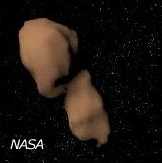
|
|
The ninth Space Roundtable, held on Wednesday in the U.S. Senate, has recommended that the search for NEOs be extended to smaller asteroids and comets with additional funding from the U.S. government. The roundtable, entitled "The Asteroid Threat: Identification and Mitigation Strategies", is organised by ProSpace and the Space Frontier Foundation and the panellists included Dr Brian Marsden, from the Minor Planet Center, Dr. Colleen Hartman and Dr. Thomas Morgan, from NASA, and Brigadier General Simon Worden, from the US Air Force, Space Command.
The panel recognised that NASA's current target is to identify all asteroids larger than 1 km and thus does not actively search for small 100 m-sized objects such as asteroid 2002 MN which passed close to the Earth in June. Additional funding would be required, beyond the $4 million NASA spends a year on NEO searches, to identify the 100,000 NEOs of this size, said the panel. The collision of such small objects with the Earth causes significant damage over areas the size of a city. However, although the collision of smaller NEOs occurs much more frequently than those of 1 km-sized objects they are unlikely to occur in an inhabited area and pose a much smaller, albeit non-zero hazard.
Republican Dana Rohrbacher, chairman of the Space and Aeronautics subcommittee of the House of Senate Science Committee, said that the potential danger to Earth from NEOs is greater than that posed by global warming. General Worden suggested that U.S. Space Command, which currently tracks artificial space debris, could host an asteroid early warning center to coordinate with non-military groups that currently search for NEOs. Worden, who was not speaking as a representative of the Air Force, has previously advocated widening the search for asteroids and comets.
The panel also noted that in the future Near Earth Objects may provide a resources of materials in space.
More info: Space.com Article
|

